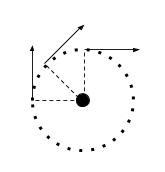1. Time/Chronology (Does that person exist in the timeframe as the claimed teacher?)
2. Location (Is that person ever at the same place as the claimed teacher?)
3. Details (Does he talk about things that are unique (not common knowledge)? Does he talk about things that another person knows as well and can attest to it?)
4. If something makes sense, it is not real. (Is that person's story too perfect? Is that person try to prove something? Someone authentic will not feel the need to prove anything.)
Certificate is needed only for a special event. If you are doing the same thing often, you do not feel like needing a certificate anymore.
When someone asks about how not to deviate, he has deviated already.
When someone has deviated, there is no way to return because in his mind, he has not deviated.
Learning is very difficult. You need blind faith.
Most of the time, you think that you are learning from someone only because you happen to match his thought on the topic. You are really just acting out in your own desired way. When the time that he tells you to do something that does not match your desire, you will refuse to do it, which means you are not really learning from this person.
If someone tries to bully you, deal with it in a way that he can't continue.
Teacher is right.
If you can see it, you get it.
If you can hear it, you get it.
If you can understand it, you get it.
One thing right, all things right. Most people can't get even one thing right.
3 bows/triangles in structural power:
1) Hand, elbow, shoulder
2) Shoulder, kua, knee
3), Kua, knee, foot
What's the relationship between moving and non-moving? Stretch
What's the demarkation between moving and non-moving? Stretch
What's neither moving nor non-moving? Stretch
I need make my actions very big.
Don't power on the top, power from the bottom.
Throw the waist into the opponent.
Play with a stick. get someone to hold the middle of the stick and you fight with it on the outside.
Getting stuck is the position we want to start. Pretend to get a stuck is a method decided by Master Chen 30 years ago.
Fix two ends, move the middle.
To pull your opponent into you, it is to push with the front foot.
Grandmaster Hong Junshen summarized taiji into ten Chinese words:
In with elbow no hand. Out with hand no elbow.
What is real? It is not recorded, and it cannot be recorded. That's the method to test if something is real.
e.g. If you wear makeup, the real you is that does not have makeup.
Master Chen emphasized pulling the opponent in using initial closing.
Getting in deep.
My bottom is getting shorter. watch out to make it bigger again.
We need physical size at first, later you need the structure to stretch to make it long.
If someone tries to bully you, deal with it in a way that he can't continue.
Teacher is right.
If you can see it, you get it.
If you can hear it, you get it.
If you can understand it, you get it.
One thing right, all things right. Most people can't get even one thing right.
3 bows/triangles in structural power:
1) Hand, elbow, shoulder
2) Shoulder, kua, knee
3), Kua, knee, foot
What's the relationship between moving and non-moving? Stretch
What's the demarkation between moving and non-moving? Stretch
What's neither moving nor non-moving? Stretch
I need make my actions very big.
Don't power on the top, power from the bottom.
Throw the waist into the opponent.
Play with a stick. get someone to hold the middle of the stick and you fight with it on the outside.
Getting stuck is the position we want to start. Pretend to get a stuck is a method decided by Master Chen 30 years ago.
Fix two ends, move the middle.
To pull your opponent into you, it is to push with the front foot.
Grandmaster Hong Junshen summarized taiji into ten Chinese words:
In with elbow no hand. Out with hand no elbow.
What is real? It is not recorded, and it cannot be recorded. That's the method to test if something is real.
e.g. If you wear makeup, the real you is that does not have makeup.
Master Chen emphasized pulling the opponent in using initial closing.
Getting in deep.
My bottom is getting shorter. watch out to make it bigger again.
We need physical size at first, later you need the structure to stretch to make it long.
